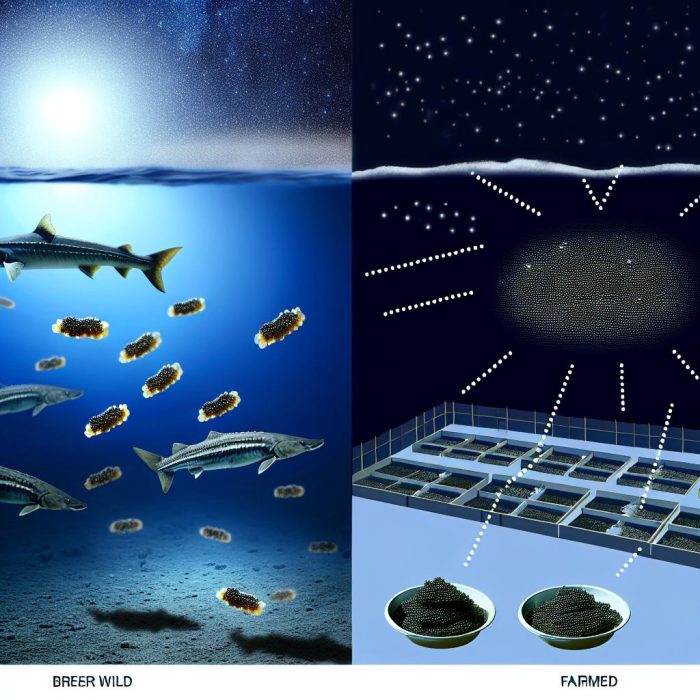Caviar: An Overview
Caviar, a delicacy revered for its luxurious image, originates from the eggs of sturgeon fish. This exotic food has captured the palates of connoisseurs around the globe due to its unique taste and texture. When delving into the market of caviar, there are mainly two categories to explore: wild caviar and farmed caviar. For consumers passionate about both quality and environmental sustainability, understanding these categories’ nuances is vital.
Sourcing and Production
Wild caviar has a storied history, being collected from sturgeon thriving in their natural ecosystems. Primarily, these sturgeons populate regions in the Caspian Sea, known for its rich biodiversity, and certain areas in the Black Sea. The methods of obtaining wild caviar are subject to strict regulations because many sturgeon species are currently endangered. Several factors, including excessive fishing and significant loss of habitat, have adversely impacted sturgeon numbers over the decades.
Conversely, farmed caviar represents a modern solution through aquaculture, wherein sturgeon are raised in controlled environments. This method serves a crucial dual purpose: preserving wild sturgeon populations while providing a steady supply of high-quality caviar. The rise of sophisticated aquaculture techniques is allowing producers to replicate and often exceed the quality standards found in wild-caught caviar. Advancements have been made that enhance the control over the growing conditions, contributing to both the quality of the end product and the conservation of natural sturgeon habitats.
Quality and Flavor Profile
The factors affecting the quality and flavor of caviar are diverse, and these can vary widely between wild and farmed types. Wild caviar generally presents a flavor profile with more complexity. This is largely attributed to the sturgeon’s diet in the wild and the variance in environmental factors found in natural habitats. This caviar is appreciated for its intricate mixture of flavors, which can include a balanced melody of salinity and nuttiness accompanied by a creamy texture that finely engages the senses.
Farmed caviar, previously judged to lack the subtlety of its wild counterpart, has shown considerable improvement in quality. Recent advances in aquaculture have led to enhanced feeding strategies that improve the taste and replicate the texture of wild caviar closely. Importantly, farmed caviar tends to offer consistency, with predictable flavor and quality, making it a preferred choice for consumers who value reliability in their culinary experiences.
Sustainability and Environmental Impact
Sustainability within caviar production is an issue of critical concern. Historically, the harvest of wild caviar has contributed to a sharp decline in sturgeon populations due to indiscriminate overfishing practices. This has prompted substantial international regulatory interventions aimed at preventing further damage. These regulations include enforced quotas and strict seasonal prohibitions designed to defend these vulnerable species and encourage population recovery.
In the realm of farmed caviar, sustainability is a focal point. The cultivation of sturgeon in aquaculture settings alleviates the fishing pressure off wild species and supports conservation initiatives. By providing a controlled farming environment, aquaculture potentially reduces adverse environmental impacts often associated with wild fishing methods, such as habitat damage and unintended bycatch, thus fostering a healthier aquatic ecosystem.
Pricing and Availability
The market pricing of caviar highlights a significant distinction between the wild and farmed varieties. Due to its rarified nature and esteemed pedigree, wild caviar typically presents a higher price point. This is partly due to its limited availability, constrained by seasonal conditions and the regulatory frameworks put in place to protect endangered sturgeon species.
Farmed caviar, on the other hand, is generally more accessible both in terms of availability and cost. The cycles of production are consistent and predictable, which both aligns with market demand and ensures broader availability. Consequently, farmed caviar becomes an attractive choice for consumers looking to indulge in this delicacy without incurring exorbitant expenses, achieving a balance between affordability and uncompromised quality.
For those interested in delving into sustainable seafood practices, additional information can be found by visiting Sustainable Seafood.
This comprehensive examination of caviar’s intricacies offers insights into making informed choices. Personal preferences regarding taste, environmental impacts, and budget constraints play an essential role when selecting between wild and farmed caviar options, ensuring a purchase that aligns with individual values and desires. Whether prioritizing flavor depth or supporting sustainable practices, each choice contributes to the rich tradition and future of caviar consumption.

